[ad_1]
The Way forward for Robotics: Minimal Handbook Steerage
Robots opening doorways and performing advanced duties have turn into a typical sight in movies. Nonetheless, what many individuals do not understand is that almost all of those spectacular feats require important human help behind the scenes. This will take the type of real-time distant management or a guided coaching session, the place the robotic is proven learn how to carry out the duty after which mimics it.
However now, new analysis carried out at ETH Zurich has launched a mannequin that goals to reduce the necessity for human intervention. The method could be damaged down into three steps: scene and motion description, route planning, and route refinement.
Step 1: Scene and Motion Description
Step one on this mannequin entails the consumer describing the scene and motion that the robotic must carry out. By offering high-level descriptions of each the robotic and the article, the system can perceive the duty specs.
Step 2: Route Planning
As soon as the scene and motion are described, the system plans a route that the robotic can comply with. This route might contain advanced maneuvers and calculations to make sure the robotic can navigate the atmosphere successfully.
Step 3: Route Refinement
Within the closing step, the system refines the deliberate route right into a minimal viable path. Because of this pointless actions and actions are eradicated, leading to a streamlined and environment friendly course of.
Need the highest robotics information in your inbox every week? Join Actuator right here.
Object-Centric and Robotic-Centric Approaches
The analysis paper classifies the system into two major classes: object-centric and robot-centric. The item-centric method focuses on duties like opening doorways or working dishwashers. Then again, the robot-centric method offers with transferring the robotic round objects.

Picture Credit: ETH Zurich
The system developed by the ETH Zurich workforce is adaptable to various kinds of robots. Nonetheless, for the sake of simplicity, the demos have been carried out utilizing a quadruped robotic known as ANYmal, developed by the startup ANYbotics. This startup originated from ETH Zurich and has been concerned in numerous analysis initiatives within the robotics discipline.
The workforce behind the analysis believes that their work can function a stepping stone in direction of creating a totally autonomous loco-manipulation pipeline. This brings us one step nearer to attaining techniques that may open doorways and carry out duties with none human intervention.
Conclusion
The analysis carried out at ETH Zurich introduces a brand new mannequin for robotics that goals to scale back the necessity for human steerage. By following a three-step means of scene and motion description, route planning, and route refinement, the system can carry out advanced duties with minimal guide intervention. The event of this technique brings us nearer to a future the place robots can autonomously navigate and manipulate their atmosphere, opening up potentialities for elevated effectivity and innovation.
Ceaselessly Requested Questions
What’s the goal of the analysis carried out at ETH Zurich?
The aim of the analysis is to develop a mannequin that requires minimal human steerage in robotics. It goals to allow robots to carry out advanced duties with out the necessity for fixed human intervention.
How does the three-step course of work?
The three-step course of entails scene and motion description, route planning, and route refinement. Within the scene and motion description step, the consumer describes what the robotic must do. Then, the system plans a route for the robotic to comply with, contemplating components like actions, forces, and get in touch with with objects. Lastly, the system refines the deliberate path to create a minimal viable path.
What are the 2 major classes of the system?
The system is split into object-centric and robot-centric approaches. The item-centric method focuses on duties like opening doorways or working home equipment, whereas the robot-centric method offers with the motion of the robotic round objects.
What’s ANYmal and why was it used within the analysis?
ANYmal is a quadruped robotic developed by the startup ANYbotics, which originated from ETH Zurich. The analysis used ANYmal as an indication platform for the system’s capabilities attributable to its versatility and adaptableness.
What’s the potential future impression of this analysis?
The analysis brings us nearer to creating totally autonomous techniques that may carry out duties with out human intervention. This has the potential to revolutionize industries and improve effectivity in numerous sectors, together with manufacturing, logistics, and automation.
[ad_2]
For extra info, please refer this link